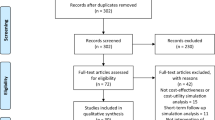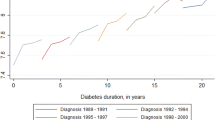Abstract
Economic models in type 1 diabetes have relied on a change in haemoglobin A1c as the link between the blood glucose trajectory and long-term clinical outcomes, including microvascular and macrovascular disease. The landscape has changed in the past decade with the availability of regulatory approved, accurate and convenient continuous glucose monitoring devices and their ability to track patients’ glucose levels over time. The data emerging from continuous glucose monitoring have enriched the clinical understanding of the disease and indirectly of patients’ behaviour. This has triggered the development of new measures proposed to better define the quality of glycaemic control, beyond haemoglobin A1c. The objective of this paper is to review recent developments in clinical knowledge brought into focus with the application of continuous glucose monitoring devices, and to discuss potential approaches to incorporate the concepts into economic models in type 1 diabetes. Based on a targeted review and a series of multidisciplinary workshops, an influence diagram was developed that captures newer concepts (e.g. continuous glucose monitoring metrics) that can be integrated into economic models and illustrates their association with more established concepts. How the additional continuous glucose monitoring-based indicators of glycaemic control may contribute to economic modelling beyond haemoglobin A1c, and more accurately reflect the economic value of novel type 1 diabetes treatments, is discussed.


Similar content being viewed by others
References
Diabetes Control Complications Trial Research Group, Nathan DM, Genuth S, Lachin J, Cleary P, Crofford O, et al. The effect of intensive treatment of diabetes on the development and progression of long-term complications in insulin-dependent diabetes mellitus. N Engl J Med. 1993;329(14):977–86.
Diabetes Control Complications Trial Research Group, Nathan DM, Bebu I, Braffett BH, Orchard TJC, Lopes-Virella CC, et al. Risk factors for cardiovascular disease in type 1 diabetes. Diabetes. 2016;65(5):1370–9.
Henriksson M, Jindal R, Sternhufvud C, Bergenheim K, Sorstadius E, Willis M. A systematic review of cost-effectiveness models in type 1 diabetes mellitus. Pharmacoeconomics. 2016;34(6):569–85.
Valentine WJ, Pollock RF, Saunders R, Bae J, Norrbacka K, Boye K. The prime diabetes model: novel methods for estimating long-term clinical and cost outcomes in type 1 diabetes mellitus. Value Health. 2017;20(7):985–91.
Tran-Duy A, Knight J, Palmer AJ, Petrie D, Lung TWC, Herman WH, et al. A patient-level model to estimate lifetime health outcomes of patients with type 1 diabetes. Diabetes Care. 2020;43(8):1741–9.
Misra A, Bloomgarden Z. Metabolic memory: evolving concepts. J Diabetes. 2018;10(3):186–7.
Beck RW, Connor CG, Mullen DM, Wesley DM, Bergenstal RM. The fallacy of average: how using HbA1c alone to assess glycemic control can be misleading. Diabetes Care. 2017;40(8):994–9.
Krass I, Schieback P, Dhippayom T. Adherence to diabetes medication: a systematic review. Diabet Med. 2015;32(6):725–37.
Miller KM, Hermann J, Foster N, Hofer SE, Rickels MR, Danne T, et al. Longitudinal changes in continuous glucose monitoring use among individuals with type 1 diabetes: international comparison in the German and Austrian DPV and U.S. T1D Exchange Registries. Diabetes Care. 2020;43(1):e1–2.
Freckmann G. Basics and use of continuous glucose monitoring (CGM) in diabetes therapy. J Lab Med. 2020;44(2):71–9.
Caro JJ, Briggs AH, Siebert U, Kuntz KM; ISPOR-SMDM Modeling Good Research Practices Task Force. Modeling good research practices: overview: a report of the ISPOR-SMDM Modeling Good Research Practices Task Force-1. Med Decis Making. 2012;32(5):667–77.
Battelino T, Danne T, Bergenstal RM, Amiel SA, Beck R, Biester T, et al. Clinical targets for continuous glucose monitoring data interpretation: recommendations from the International Consensus on Time in Range. Diabetes Care. 2019;42(8):1593–603.
Kovatchev B. Glycemic variability: risk factors, assessment, and control. J Diabetes Sci Technol. 2019;13(4):627–35.
Moscardo V, Herrero P, Reddy M, Hill NR, Georgiou P, Oliver N. Assessment of glucose control metrics by discriminant ratio. Diabetes Technol Ther. 2020;22(10):719–26.
Danne T, Nimri R, Battelino T, Bergenstal RM, Close KL, DeVries JH, et al. International consensus on use of continuous glucose monitoring. Diabetes Care. 2017;40(12):1631–40.
Peyser TA, Balo AK, Buckingham BA, Hirsch IB, Garcia A. Glycemic variability percentage: a novel method for assessing glycemic variability from continuous glucose monitor data. Diabetes Technol Ther. 2018;20(1):6–16.
Herrero P, Alalitei A, Reddy M, Georgiou P, Oliver N. Robust determination of the optimal continuous glucose monitoring length of intervention to evaluate long-term glycaemic control. Diabetes Technol Ther. 2021;23(4):314–9.
Neylon OM, Baghurst PA, Cameron FJ. The minimum duration of sensor data from which glycemic variability can be consistently assessed. J Diabetes Sci Technol. 2014;8(2):273–6.
American Diabetes Association. 5. Facilitating behavior change and well-being to improve health outcomes: standards of medical care in diabetes: 2021. Diabetes Care. 2021;44(Suppl. 1):S53–72.
Ehrhardt N, Al ZE. Continuous glucose monitoring as a behavior modification tool. Clin Diabetes. 2020;38(2):126–31.
American Diabetes Association. 7. Diabetes technology: standards of medical care in diabetes: 2021. Diabetes Care. 2021;44(Suppl. 1):S85–99.
Aitken M, Villa P, Lamotte M, Tewary V, Ramos M. Advancing glycemic management in people with diabetes. New approaches and measures. 2019. https://www.iqvia.com/insights/the-iqvia-institute/reports/advancing-glycemic-management-in-people-with-diabetes. Accessed 1 May 2022.
Beck RW, Bergenstal RM, Riddlesworth TD, Kollman C, Li Z, Brown AS, et al. Validation of time in range as an outcome measure for diabetes clinical trials. Diabetes Care. 2019;42(3):400–5.
Avari P, Uduku C, George D, Herrero P, Reddy M, Oliver N. Differences for percentage times in glycemic range between continuous glucose monitoring and capillary blood glucose monitoring in adults with type 1 diabetes: analysis of the REPLACE-BG dataset. Diabetes Technol Ther. 2020;22(3):222–7.
Vigersky RA, McMahon C. The relationship of hemoglobin A1C to time-in-range in patients with diabetes. Diabetes Technol Ther. 2019;21(2):81–5.
Beck RW, Bergenstal RM, Cheng P, Kollman C, Carlson AL, Johnson ML, et al. The relationships between time in range, hyperglycemia metrics, and HbA1c. J Diabetes Sci Technol. 2019;13(4):614–26.
Fabris C, Heinemann L, Beck R, Cobelli C, Kovatchev B. Estimation of hemoglobin A1c from continuous glucose monitoring data in individuals with type 1 diabetes: is time in range all we need? Diabetes Technol Ther. 2020;22(7):501–8.
Schofield J, Ho J, Soran H. Cardiovascular risk in type 1 diabetes mellitus. Diabetes Ther. 2019;10(3):773–89.
Lachin JM, Bebu I, Bergenstal RM, Pop-Busui R, Service FJ, Zinman B, et al. Association of glycemic variability in type 1 diabetes with progression of microvascular outcomes in the Diabetes Control and Complications Trial. Diabetes Care. 2017;40(6):777–83.
Lu J, Ma X, Zhang L, Mo Y, Lu W, Zhu W, et al. Glycemic variability modifies the relationship between time in range and hemoglobin A1c estimated from continuous glucose monitoring: a preliminary study. Diabetes Res Clin Pract. 2020;161: 108032.
Gimenez M, Tannen AJ, Reddy M, Moscardo V, Conget I, Oliver N. Revisiting the relationships between measures of glycemic control and hypoglycemia in continuous glucose monitoring data sets. Diabetes Care. 2018;41(2):326–32.
Charleer S, De Block C, Van Huffel L, Broos B, Fieuws S, Nobels F, et al. Quality of life and glucose control after 1 year of nationwide reimbursement of intermittently scanned continuous glucose monitoring in adults living with type 1 diabetes (FUTURE): a prospective observational real-world cohort study. Diabetes Care. 2020;43(2):389–97.
Soupal J, Petruzelkova L, Grunberger G, Haskova A, Flekac M, Matoulek M, et al. Glycemic outcomes in adults with T1D are impacted more by continuous glucose monitoring than by insulin delivery method: 3 years of follow-up from the COMISAIR study. Diabetes Care. 2020;43(1):37–43.
Deshmukh H, Wilmot EG, Gregory R, Barnes D, Narendran P, Saunders S, et al. Effect of flash glucose monitoring on glycemic control, hypoglycemia, diabetes-related distress, and resource utilization in the Association of British Clinical Diabetologists (ABCD) nationwide audit. Diabetes Care. 2020;43(9):2153–60.
Nationella Diabetesregistret. Årsrapport 2020 ÅRS Resultat. 2020. https://www.ndr.nu/pdfs/Arsrapport_NDR_2020.pdf. Accessed 1 May 2022.
Fiallo-Scharer R, Diabetes Research in Children Network Study G. Eight-point glucose testing versus the continuous glucose monitoring system in evaluation of glycemic control in type 1 diabetes. J Clin Endocrinol Metab. 2005;90(6):3387–91.
Hirsch IB, Welsh JPB, Calhoun P, Puhr S, Walker TC, Price DA. Associations between HbA1c and continuous glucose monitoring-derived glycaemic variables. Diabet Med. 2019;36(12):1637–42.
Nathan DM, Kuenen J, Borg R, Zheng H, Schoenfeld D, Heine RJ, et al. Translating the A1C assay into estimated average glucose values. Diabetes Care. 2008;31(8):1473–8.
Omar AS, Salama A, Allam M, Elgohary Y, Mohammed S, Tuli AK, et al. Association of time in blood glucose range with outcomes following cardiac surgery. BMC Anesthesiol. 2015;15:14.
Virk SA, Donaghue KC, Cho YH, Benitez-Aguirre P, Hing S, Pryke A, et al. Association between HbA1c variability and risk of microvascular complications in adolescents with type 1 diabetes. J Clin Endocrinol Metab. 2016;101(9):3257–63.
El Malahi A, Van Elsen M, Charleer S, De Ridder F, Ledeganck K, et al. Chronic complications versus glycaemic variability, time in range and HbA1c in people with type 1 diabetes: sub study of the RESCUE-trial. Belgian Endocrine Soc. 2020;2020:71.
Acknowledgements
The authors thank Júlia Palotás, Research Associate at Evidera for her assistance with screening and extracting literature and editorial help. The authors also thank two anonymous reviewers who provided very helpful comments on an earlier version of the manuscript.
Author information
Authors and Affiliations
Corresponding author
Ethics declarations
Funding
This study was funded by Eli Lilly and Company.
Conflicts of Interest/Competing Interests
ÁB, KM, JJC and DJK are employees of Evidera PPD, a consultancy that provides services to the pharmaceutical industry. Payments are made to Evidera PPD. ERH, JC, BDB and JPB are full-time employees of Eli Lilly and Company. ERH, JC, JPB and BDB hold stocks in Eli Lilly and Company.
Ethics Approval
Not applicable.
Consent to Participate
Not applicable.
Consent for Publication
Not applicable.
Availability of Data and Material
Data sharing is not applicable to this article as no datasets were generated or analysed during the current study.
Code Availability
Not applicable.
Author contributions
Á Benedict, ER Hankosky, K Marczell, J Chen made substantial contributions to concept, design of the review, analysis and interpretation as well as the drafting of the manuscript. D Klein, JJ Caro, JP Bae and BD Benneyworth contributed to the design, analysis and interpretation. The manuscript was drafted by Á Benedict, ER Hankosky, K Marczell, J Chen and JJ Caro. DJ Klein and JP Bae provided critical revision of the manuscript for important intellectual content. All authors participated sufficiently in the work to agree to be accountable for all aspects of the work in ensuring that questions related to the accuracy or integrity of any part of the work are appropriately investigated and resolved.
Additional information
Jieling Chen was at Lilly at the time of the research and writing the manuscript.
Supplementary Information
Below is the link to the electronic supplementary material.
Rights and permissions
About this article
Cite this article
Benedict, Á., Hankosky, E.R., Marczell, K. et al. A Framework for Integrating Continuous Glucose Monitor-Derived Metrics into Economic Evaluations in Type 1 Diabetes. PharmacoEconomics 40, 743–750 (2022). https://doi.org/10.1007/s40273-022-01148-4
Accepted:
Published:
Issue Date:
DOI: https://doi.org/10.1007/s40273-022-01148-4




